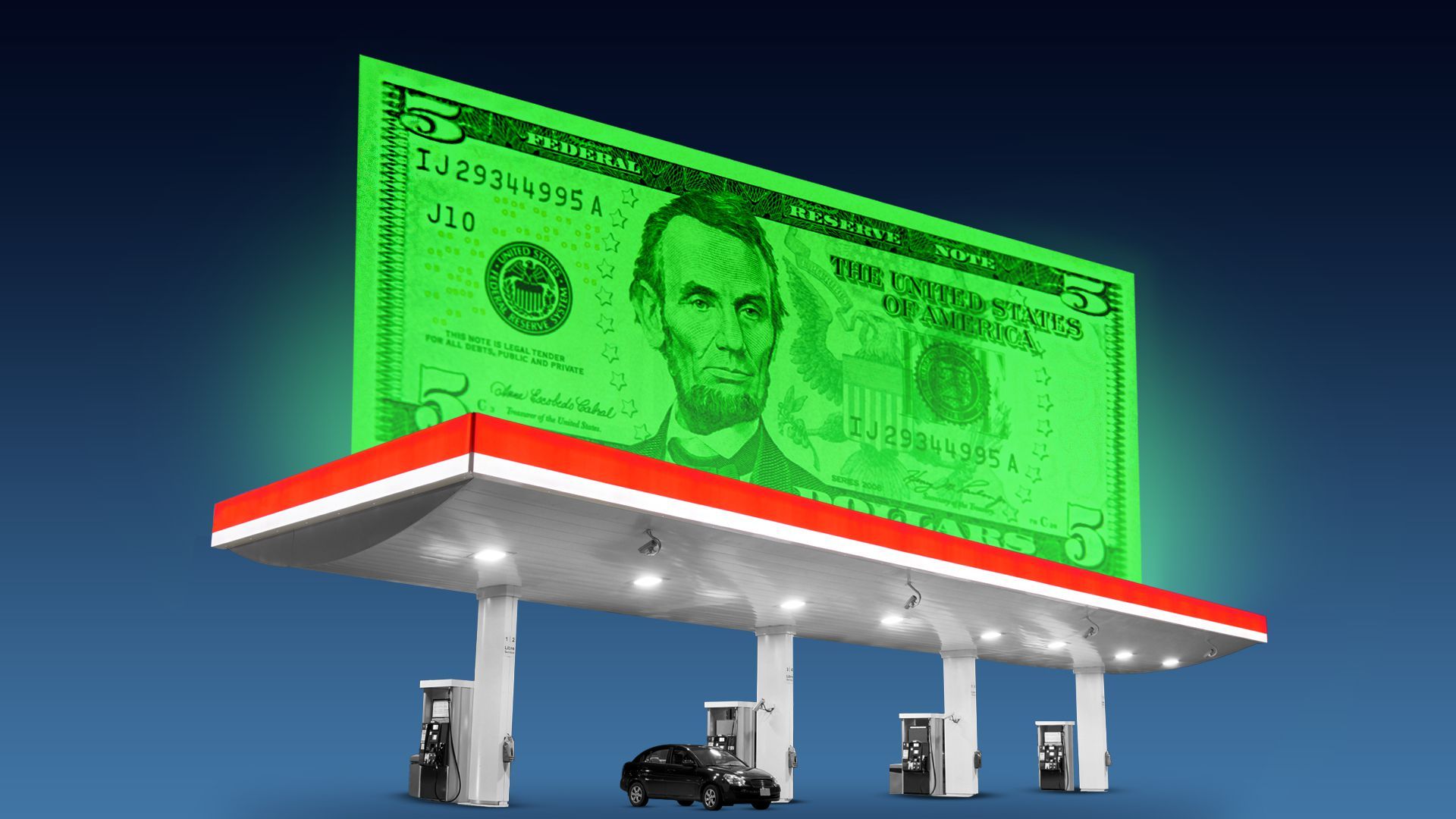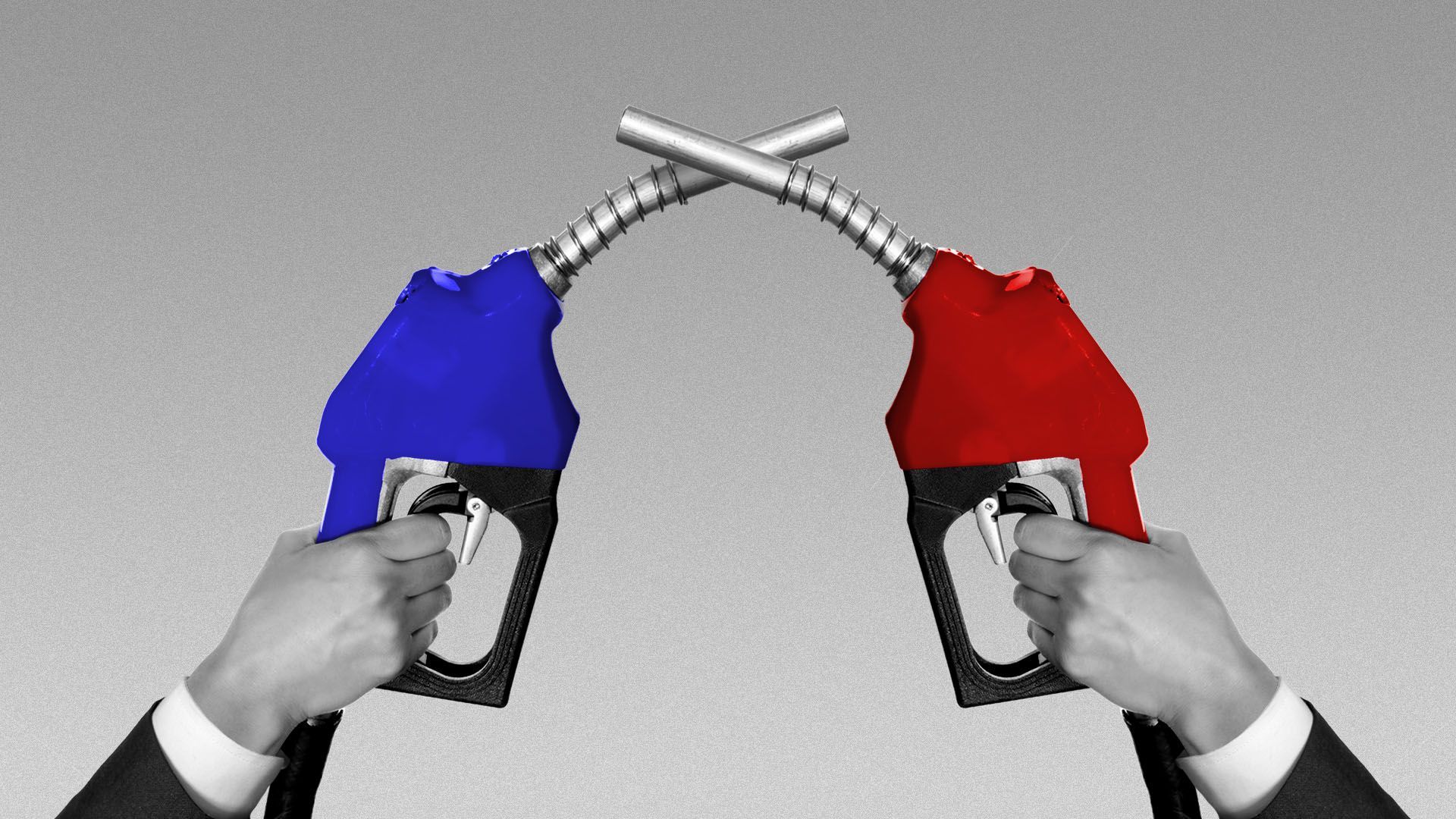| | | | | | | | | | | Axios Markets | | By Matt Phillips and Emily Peck · Jun 10, 2022 | | 🚨 Folks! Today we're doing something a little different. A whole newsletter devoted to one topic: gas prices. Why? The average price at U.S. pumps is about to cross the symbolic $5 mark nationally, according to AAA. And that feels like a real milestone on the inflationary journey we're all on. (Don't forget, the latest update on inflation — the Consumer Price Index — is due this morning at 8:30 ET.) 🚚 Buckle up, let's do this! Today's newsletter, edited by Kate Marino, is 1,064 words, 4 minutes. | | | | | | 1 big thing: A fiver |  | | | Illustration: Natalie Peeples/Axios | | | | Gasoline prices are about a cent shy of the never-before-seen national average level of $5 a gallon, and it's unclear how Americans — and the economy — will react. Why it matters: Prices at the pump play an outsized role in the minds of Americans and are often seen as harbingers for everything from plummeting presidential approval ratings to ugly recessions. Driving the news: The daily U.S. average national price for a gallon of regular climbed to $4.99 as of this morning, according to AAA. - And surging prices in the wholesale futures markets — which are leading indicators of retail prices — suggest there's little hope for near-term relief.
State of play: Setting aside the brief, unique COVID recession of 2020, 10 of the 11 recessions the U.S. has experienced since World War II have been preceded by a sharp rise in energy prices. How it works: In general, steep increases in oil prices — and by extension gasoline prices — are thought to reduce consumption. - They leave people with less disposable income for everyday shopping after paying higher energy bills.
- Make people uncertain about the future, causing them to ...
- Delay purchases of large goods like cars and washing machines, and ...
- Sock away any extra money they can in precautionary savings.
- All of which can slow down a heavily consumption-driven economy.
Yes, but: Economists who've looked into the relationship suggest the price spikes that have historically preceded recessions could be more a case of correlation, than causation. - For instance, former Federal Reserve chair Ben Bernanke, and co-authors, have argued in academic work that it's not the energy shock that causes the slump, but rather the Fed's efforts to limit the inflationary impact of the energy price surge, by hiking rates.
The bottom line: Whether it's the energy price rise itself, or the Fed's effort to keep that inflation in check — as Bernanke's successor Jerome Powell is trying to do right now — if history is any guide the outlook for the economy is getting more uncertain by the day. |     | | | | | | 2. Charted: Let's get "real" |  Note: Historical data is annual, monthly and since 1990, weekly; Data: Energy Information Administration; Chart: Axios Visuals Although consumers have never seen prices this high at the pump, we're still a bit short of the record "real," or inflation-adjusted, high. - That came in June 2008, when gasoline prices hit roughly $5.44 in today's dollars.
Some see that previous peak as the straw that broke the American consumer's back. - High gas prices ate into household incomes, starting a cycle of missed mortgage payments — on, it should be said, incredibly poorly underwritten loans — which then spiraled into a financial crisis and deep recession.
Yes, but: Maybe it's not all bad. The surge in gas prices could also nudge consumers toward hybrid and electric vehicles, long a goal for those focused on cutting carbon emissions to slow climate change. |     | | | | | | 3. Catch up quick: Gas price edition | | ⛽️ Fed up Massachusetts gas station owner stops selling fuel. (AP) ⛽️ In deep-blue California, gas prices worry Democrats. (NYT) ⛽️ Out-of-gas calls to AAA rise, as drivers test limits of gauges. (WP) ⛽️ Costco aims to limit fill-ups to members. (Yahoo) |     | | | | | | A message from Axios | | Win the race for (remote) talent | | |  | | | | Axios has job boards to recruit top talent for your remote and local job opportunities. Reach smart professionals that visit Axios daily to make decisions about where to work, what to do and where to live. Post your job opening on Axios. | | | | | | 4. It's a political matter |  | | | Illustration: Sarah Grillo/Axios | | | | With surging gasoline prices thought to be kryptonite for incumbent candidates, $5 gas threatens to transform a tough political environment into a downright dire one for the Democrats ahead of the midterms, Matt writes. What's happening: The surge in prices above a never-before-seen big round number will only make inflation a more central issue. - Polling by Gallup shows that inflation now ranks as the top economic concern among Americans, the first time it's been in that position since 1984.
- Pew Research recently reported that seven out of 10 respondents see inflation as a big problem.
- "No other top concern comes close," Pew analysts wrote.
Between the lines: Gas prices are hugely important in the car-reliant suburbs, an area where President Biden and the Democrats are thought to have essentially won the 2020 election. - Crucial swing states such as Michigan, Ohio and Wisconsin are also now seeing some of the largest increases in gasoline prices, according to AAA.
The bottom line: Unless something changes fast, this looks really bad for the Democrats. |     | | |  | | | | If you like this newsletter, your friends may, too! Refer your friends and get free Axios swag when they sign up. | | | | | | | | 5. Who it hurts the most |  Data: U.S. Bureau of Labor Statistics via Nick Maggiulli; Chart: Erin Davis/Axios Visuals For the highest earners, the pain at the pump is more psychological than anything else. But for lower-income Americans, high gas prices can set off a cycle of hardship, Emily writes. By the numbers: Those at the top spent the equivalent of about 2% of their income on gas in 2019. That's the most recent year for which the Bureau of Labor Statistics has survey data that are not skewed by weird pandemic behavior. - Those at the lower end of the income scale devoted 8% of their after-tax income to gas in 2019. (Although many living in urban areas without cars are spared the expense.)
- In 2008, when gas prices hit a record high, that group spent close to 12%.
Worth noting: This data looks at gas expenditures as a percentage of income. A more common practice is to slice the numbers as a percentage of overall household spending. - It looks different that way: The lowest 20% of earners devoted 3.7% of their spending to gas versus 2.7% for the highest earners, per BLS.
- But, we reckon, the income percentages hit home. When you're living paycheck to paycheck, and you need to drive, your income gets gobbled up.
Meanwhile, more recent data, from Bank of America, shows that Americans who earn less than $50,000 a year are currently spending nearly 10% of their credit card bills on gas, compared with 6% for households earning more than $125,000. Where it stands: The saving grace now would be that the job market is a lot healthier than it was in 2008. On the other hand, for those who must drive to work — higher gas prices are essentially a pay cut. - "It can create a cascade of other hardships," said former Federal Reserve economist Claudia Sahm. If an increased share of your money goes to gas, you have to make painful choices about where that cash comes from.
- This comes at a time of rising food prices, which are also pinching lower-income households.
The bottom line: Gas is "the price that everybody sees," Sahm said. "I mean people hate this." |     | | | | | | The bottom line: Why gas prices matter | | "..[I]nflation expectations are driven by gas prices. At least at the household level, that is what people see and that's how they think about inflation." — Treasury Secretary Janet Yellen, yesterday, speaking at the New York Times DealBook D.C. policy forum. |     | | | | | | A message from Axios | | Win the race for (remote) talent | | |  | | | | Axios has job boards to recruit top talent for your remote and local job opportunities. Reach smart professionals that visit Axios daily to make decisions about where to work, what to do and where to live. Post your job opening on Axios. | | | | ⛽️ 1 thing Emily loves: The market attached to my local gas station gives you a free 10 oz cup of coffee when you fill-up the tank. The coffee is meh, but what makes it a treat is that they have this delicious, but definitely bad for you, creamer that tastes like ice cream. I like the hazelnut one. (Matt says that's gross, though. Reply to this email and let us know I'm right. Er, I mean, let us know what you think.) |  | It's called Smart Brevity®. Over 200 orgs use it — in a tool called Axios HQ — to drive productivity with clearer workplace communications. | | | | | | Axios thanks our partners for supporting our newsletters. If you're interested in advertising, learn more here.
Sponsorship has no influence on editorial content. Axios, 3100 Clarendon Blvd, Arlington VA 22201 | | | You received this email because you signed up for newsletters from Axios.
Change your preferences or unsubscribe here. | | | Was this email forwarded to you?
Sign up now to get Axios in your inbox. | | | | Follow Axios on social media:    | | | | | |












No comments:
Post a Comment